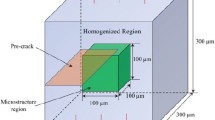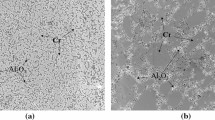Abstract
Advanced manufacturing techniques such as extrusion-based methods have enabled the fabrication of ceramic composites with ordered inclusion phases (i.e. the size and position of the inclusion can be precisely controlled) to improve their overall strength and toughness. Conventional theories, simulation approaches, and experimental methods for analyzing fracture in composites with randomly dispersed inclusion phases (resulting in homogeneous, isotropic effective properties) become inadequate at understanding and designing composites with ordered inclusions for enhancing effective properties such as toughness. In addition, existing methods for analyzing fracture in composites can be computationally expensive and pose challenges in accurately capturing experimentally observed fracture growth. For example, extended finite element and phase-field methods are computationally expensive in evaluating the large design space of possible inclusion arrangements enabled by the new manufacturing techniques. In this work, a closed-form analytical model for the mixed-mode stress intensity factor in a composite with selected inclusion arrangements is presented, which expedites the analysis for various composite designs. Moreover, the fracture initiation calculation is adapted to approximate crack propagation with computational efficiency. The accuracy of this model for predicting fracture initiation is validated by linear elastic fracture mechanics analysis using the finite element method. The prediction of fracture propagation is validated using a phase-field model, as well as a 4-point bending experiment. Finally, the model is applied to analyze three different composite inclusion arrangements to study the effect of various material combinations and geometries on the overall toughness of the composite; a complete sampling of (and optimization) over the entire design space, however, is beyond the scope of this work. The relative increase in crack length (compared to a homogeneous material) is used as a metric to compare the relative toughness of three different composite designs. Within these designs, using the fast-running approximate method, the effect of the ratio of inclusion radius to inclusion spacing, and the elastic mismatch on the resulting crack length are compared to determine the composite arrangements that result in the greatest toughness enhancement for selected material properties. In particular, a multi-phase cubic array resulted in the greatest toughness enhancement of the designs considered.












Similar content being viewed by others
References
Anderson T (2005) Fracture mechanics: fundamentals and applications, 3rd edn. Taylor & Francis, London
Bourdin B, Francfort GA, Marigo JJ (2008) The variational approach to fracture. J Elast 91:5–148
Cotterell B (1965) On brittle fracture paths. Int J Fract Mech 1:96–103
Danzer R (1992) A general strength distribution function for brittle materials. J Eur Ceram Soc 10:461–472
D’Angio’ A, Zou J, Binner J, Ma HB, Hilmas G, Fahrenholtz W (2018) Mechanical properties and grain orientation evolution of zirconium diboride–zirconium carbide ceramics. J Eur Ceram Soc 38:391–402
Els AL (2014) Development and characterization of spiral additions in a ceramic matrix. Master’s thesis. Missouri University of Science and Technology
Eshelby JD (1975) The elastic energy-momentum tensor. J Elast 5:321–335
Evans AG, Wiederhorn SM (1984) Proof testing of ceramic materials—an analytical basis for failure prediction. Int J Fract 26:355–368
Faber K, Evans A (1983a) Crack deflection processes I. Theory. Acta Metall 31:565–576
Faber K, Evans A (1983b) Crack deflection processes II. Experiment. Acta Metall 31:577–584
Fett T, Diegele E, Rizzi G (1996) Calculation of stress fields near inclusions by use of the fracture mechanics weight function. Eng Fract Mech 53:17–22
Gao H, Ji B, Jäger IL, Arzt E, Fratzl P (2003) Materials become insensitive to flaws at nanoscale: lessons from nature. Proc Natl Acad Sci 100:5597–5600
Green DJ (1981) Stress-induced microcracking at second-phase inclusions. J Am Ceram Soc 64:138–141
Griffith AA, Taylor GI (1921) VI. The phenomena of rupture and flow in solids. Philos Trans R Soc Lond 221:163–198
He MY, Hutchinson JW (1989) Kinking of a crack out of an interface. J Appl Mech 56:270–278
Helsing J (1999) Stress intensity factors for a crack in front of an inclusion. Eng Fract Mech 64:245–253
Hilmas G, Watts J (2006) Tailoring the properties of ceramic-based composites using co-extrusion processing. In: 11th international ceramics congress, Trans Tech Publications Ltd. pp 1385–1393
Hilmas GH, Fahrenholtz W, Watts J (2012) Method for toughening via the production of spiral architectures through powder loaded polymeric extrusion and toughened materials formed thereby. U.S. Patent US8192853B2
Hoy CV, Barda A, Griffith M, Halloran JW (1998) Microfabrication of ceramics by co-extrusion. J Am Ceram Soc 81:152–158
Lambropoulos J (1986) Shear, shape and orientation effects in transformation toughening. Int J Solids Struct 22:1083–1106
Li Z, Chen Q (2002) Crack-inclusion interaction for mode I crack analyzed by Eshelby equivalent inclusion method. Int J Fract 118:29–40
Lipetzky P, Knesl Z (1995) Crack-particle interaction in a two-phase composite Part II: crack deflection. Int J Fract 73:81–92
Makarian K, Santhanam S, Wing ZN (2016) Coefficient of thermal expansion of particulate composites with ceramic inclusions. Ceram Int 42:17659–17665
Miehe C, Welschinger F, Hofacker M (2010) Thermodynamically consistent phase-field models of fracture: variational principles and multi-field FE implementations. Int J Numer Methods Eng 83:1273–1311
Miller R, Ortiz M, Phillips R, Shenoy V, Tadmor E (1998) Quasicontinuum models of fracture and plasticity. Eng Fract Mech 61:427–444
Neuman EW, Hilmas GE, Fahrenholtz WG (2017) Processing, microstructure, and mechanical properties of zirconium diboride–boron carbide ceramics. Ceram Int 43:6942–6948
Ritchie RO, Buehler MJ, Hansma P (2009) Plasticity and toughness in bone. Phys Today 62:41
Sih GC, Hilton PD, Wei RP (1970) Exploratory development o fracture mechanics of composite systems. Technical Report
Stam G, van der Giessen E, Meijers P (1994) Effect of transformation-induced shear strains on crack growth in zirconia-containing ceramics. Int J Solids Struct 31:1923–1948
Twickler R, Twickler M, Dahl W (1986) Two- and three-dimensional elastic-plastic stress analysis for a double edge notched tension specimen. Eng Fract Mech 24:553–565
Wang C, Libardi W, Baldo J (1998) Analysis of crack extension paths and toughening in a two phase brittle particulate composite by the boundary element method. Int J Fract 94:177–188
Wei C, Wu C, Wojnar C (2019) Effect of patterned inclusions on the fracture behavior of ceramic composites. Compos Part B Eng 172:564–592
Williams ML (1956) On the stress distribution at the base of a stationary crack. J Appl Mech 24:109–114
Yang L, Chen Q, Li Z (2004) Crack-inclusion interaction for mode II crack analyzed by Eshelby equivalent inclusion method. Eng Fract Mech 71:1421–1433
Acknowledgements
The authors acknowledge support from the NSF CMMI Award number 1930881. The authors also thank the Center of Infrastructure Engineering Studies and the Intelligent System Center at the Missouri University of Science and Technology for support.
Author information
Authors and Affiliations
Corresponding author
Additional information
Publisher's Note
Springer Nature remains neutral with regard to jurisdictional claims in published maps and institutional affiliations.
Appendices
Appendix A: Approximate stress intensity factor of a kinked crack in a 4-point bending test
The parameters c and d, used in (2) are functions of the kink angle, \(\omega \), with an infinitesimal kink length. This approximation is asymptotically accurate for small kink angles (in a homogeneous material) and is given by:
where \(j=\sqrt{-1}\) (Cotterell 1965; He and Hutchinson 1989; Williams 1956).
Appendix B: Influence of a nearby inclusion on a straight crack
The perturbation in stress intensity factor in mode I and II fracture due to the difference in material properties of the inclusions and the matrix is dictated by the following coefficients appearing in (3):
where \(\nu \) is Poisson’s ratio (assumed to be same for the inclusions and the matrix) and
is the ratio of the Young modulus of the inclusion, \(E_\text {inc}\), to the Young modulus of the matrix, \(E_\text {mat}\). Note that in most cases, the Poisson ratio of the composite materials will not be identical. Hence, the results predicted from this model will be most accurate when the Poisson ratios of the constituents are nearly the same value. Despite this assumption, the model is still able to accurately capture experimental results.
Rights and permissions
About this article
Cite this article
Thakur, A.R., Wei, C., Wu, C. et al. A computationally efficient approach for predicting toughness enhancement in ceramic composites with tailored inclusion arrangements. Int J Fract 221, 171–190 (2020). https://doi.org/10.1007/s10704-020-00421-x
Received:
Accepted:
Published:
Issue Date:
DOI: https://doi.org/10.1007/s10704-020-00421-x




